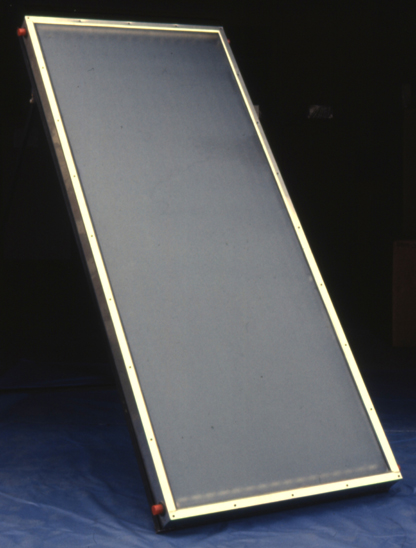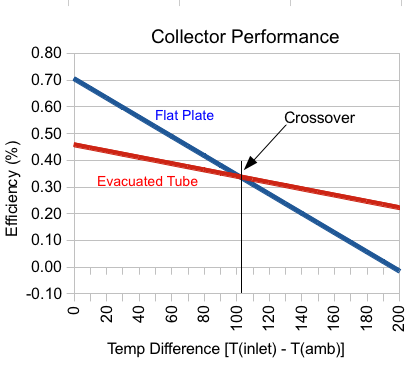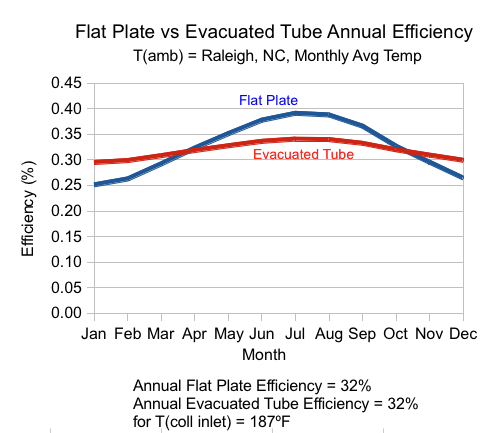Evacuated Tube Versus Flat Plate Solar Hot Water Panels – Who Has The Upper Hand?
I was recently discussing the different types of solar hot water collectors with a business owner considering the purchase of a system. He had heard a lot about evacuated tube collectors, but he knew I used flat plate collectors. So he asked me which type was better. “The answer is simple,” I told him. “Both.”
To understand the difference, let’s first discuss some basic physics. There are three ways heat (energy) is transferred. They are radiation, conduction, and convection. Each of these transfer methods is active in all heating and cooling systems, including solar. However, the three methods may not be equal in importance for a given system.
Radiation is the transfer of energy through space, with no medium helping. People used to think that solar radiation could not possibly travel through “empty” space to the earth. There had to be something between the two to conduct the energy. It was called the “ether”. We now know that radiation travels through a vacuum with nothing helping. Most people understand the radiation energy from the sun on their body, or from a fireplace, but are not aware that radiation is emitted from every body that has a temperature above absolute zero. To illustrate, place your hand about 1/2 inch from your face. You will feel the radiation transfer between your hand and your face.
Second, there is conduction. We all know about conduction when we touch a hot surface. Heat is transferred by molecules banging together in a solid surface. If you heat one end of a copper pipe and hold on to the other, you will feel the heat that transfers from the hot end to the colder end.
Third is convection. Convective heat transfer means moving (convecting) the hot molecule from one place to another, where it transfers its heat to something colder. A hot air furnace moves heated air into the house. Hot water moves through pipes from the heater to the tap. When cold air blows across our skin, it picks up the surface heat and carries it away, hence the “wind chill” factor on the weather news.
So, we need to understand that radiation is the main way solar collectors gain energy, conduction is the way the heat is transferred through the metal absorber plate into the water, and convection is the way the heat is transported by the water flowing to the storage tank. One other concept we need to understand is that the amount of heat transferred by conduction and convection depends on the temperate difference between the hot and cold ends of the system. For example, if the temperature between the hot and cold ends of a copper pipe is doubled, the amount of heat transported between the two is doubled. The cold end will heat up twice as fast. Likewise in the convection wind chill example, the greater the temperature difference between the wind and our skin, the more energy is transferred.
Collectors also lose heat by radiation, conduction, and convection. Just like a fire in a fireplace, a hot collector absorber plate will radiate energy back out into space. There are special electroplated black coatings that radiate less than an ordinary hot surface. They are called “selective surfaces”, because they don’t radiate like normal surfaces, which are called “black bodies”. Most black coatings on solar collectors are selective surfaces. They may absorb 95% of the solar radiation hitting them, but reradiate only 10% as much as an ordinary black body. Black stove paint is a black body and can reradiate 30% of the energy collected back into space.

Figure 1. Flat Plate Solar Collector
Now back to the question. Which type of solar collector is better? The answer is found by comparing the performance curves of both types of collectors on the same graph. Figure 2 shows the performance curves of typical flat plate and evacuated tube collectors. A typical flat plate collector has a maximum efficiency of about 70% at the left end of the graph where the inlet water temperature is equal to the outside (ambient) air temperature. That is, when there is no temperature difference and and none of the energy captured is lost to the surroundings. As we move to the right on the graph, the temperature difference between the water entering the collector and the ambient air increases, and the efficiency of the collector falls as energy is lost to the colder surroundings. At some temperature difference, the collector loses as much energy as it gains and the efficiency is zero.
Evacuated tube (ET) collectors may be only 45% efficient when the entering water and air temperatures are equal and there are no losses. However, the evacuated chamber surrounding the absorber plate acts as super insulation and conducts much less heat away from the absorber. ET collector efficiency does not fall off as fast at higher temperature differences.
Plotted on the same graph, the two curves cross each other around the 103oF differential temperature mark. This is called the crossover point. Before the crossover point (to the left on the graph) flat plate collectors are more efficient. To the right of the crossover point, evacuated tube collectors are more efficient. Due to their higher price and lower durability, the economic crossover point can be moved farther to the right before evacuated tube collecctors should be selected.
For example, let’s say it is 40oF degrees outside. A flat plate collector will be more efficient as long as the entering water temperature is below 143oF. An ET collector will be more efficient when the water temperature rises above 143oF. On a day where the outside temperature is 0oF, the efficiency crossover point occurs when the entering water temperature hits 103oF. Note that we are only interested in the average daytime temperature when the collectors are running, not the coldest possible temperature in that location. The average daytime temperature for a given month is a good number for this calculation.
A better way is to do a comparison over a whole year as shown in fig. 3. After all, we are not going to swap out collectors monthly based on which is better. For example, in a location whose average daily temperature ranges from 39ºF in the winter to 80ºF in summer (mid North Carolina), the annual efficiency of the flat plate and evacuated tube collectors is identical when the inlet temperature going into the collector is 187 ºF. That is, over a whole year cycle, the crossover point for these particular collectors in mid North Carolina climate is 187 ºF.
Domestic hot water (DHW) and space heating (SH) applications occur well below this crossover temperature.
However, in northern climates with much lower average temperatures, the crossover point may favor ET collectors.
So, when it comes to choosing between evacuated tube and flat plate solar hot water collectors, the most critical factor is where the crossover occurs and how that compares with the delivery temperatures needed for a given application.
Good solar engineering involves designing systems that can operate at the lowest possible temperature. Heating ground water starting at 40 or 50ºF makes much more sense than trying to raise the temperature of 120ºF water. Likewise, preheating forced air starting at room temperature is preferable to trying to add heat at the output temperature.
A partial list of commercial applications that are best served by flat plate panels include:
College Dormitories,
Military barracks and housing
Jails and Prisons
Retirement Communities
Hospitals, Nursing Homes
Carwashes
School Cafeterias
Laundries
It certainly helps to work with a solar professional who understands the differences between collectors and is not just trying to promote one over the other to make a sale.
Dr. Ben


